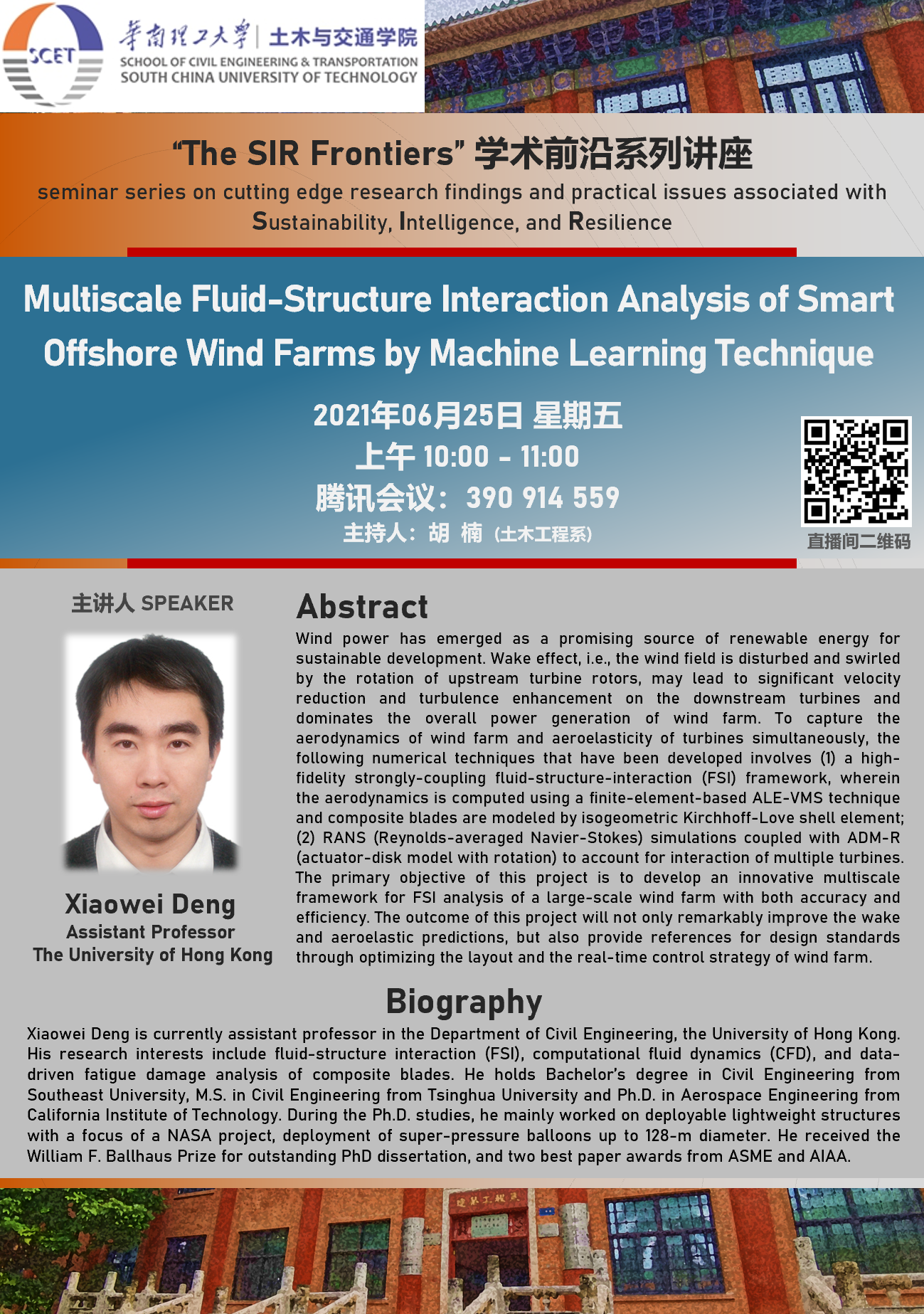题 目:Multiscale Fluid-Structure Interaction Analysis of Smart Offshore Wind Farms by Machine Learning Technique (基于机器学习技术的智能海上风电场多尺度流固耦合分析)
时 间:2021年06月25日10:00-11:00
地 点:腾讯会议 ID:390 914 559
腾讯直播间:https://meeting.tencent.com/l/THvyACrHjgN4
报告人:邓晓蔚助理教授(香港大学)
个人主页http://www.civil.hku.hk/pp-dengxw.html
欢迎广大师生参加
土木与交通学院
2021年06月18日

报告人简介:
邓晓蔚博士现就任香港大学土木工程系助理教授,他的研究方向包括流固耦合(FSI)、计算流体动力学(CFD)和复合材料叶片的数据驱动疲劳损伤分析。邓博士先后在东南大学获得土木工程学士学位、清华大学获得土木工程硕士学位,和加州理工学院获得航空航天工程博士学位。在博士期间,他致力于研究可展开的轻质结构,参与了NASA一个关于展开直径达128米的超压气球的重点项目。邓博士曾获加州理工学院William F. Ballhaus 优秀博士论文奖以及ASME和AIAA颁发的两项最佳论文奖。
Xiaowei Deng is currently assistant professor in the Department of Civil Engineering, the University of Hong Kong. His research interests include fluid-structure interaction (FSI), computational fluid dynamics (CFD), and data-driven fatigue damage analysis of composite blades. He holds Bachelor’s degree in Civil Engineering from Southeast University, M.S. in Civil Engineering from Tsinghua University and Ph.D. in Aerospace Engineering from California Institute of Technology. During the Ph.D. studies, he mainly worked on deployable lightweight structures with a focus of a NASA project, deployment of super-pressure balloons up to 128-m diameter. He received the William F. Ballhaus Prize for outstanding PhD dissertation, and two best paper awards from ASME and AIAA.
报告摘要:
风力发电已成为一种有望实现可持续发展的可再生能源。尾迹效应,即上游风力机转子的旋转对风场的扰动和旋转,可能导致下游风力机的风速显著降低和湍流增强,并在整个风电场发电中占据主导地位。为了同时捕捉风电场的空气动力学和涡轮机的气动弹性,已开发的以下数值技术包括:
(1)高保真、强耦合的流固耦合(FSI)框架,其中空气动力学采用基于有限元的ALE-VMS技术计算,复合材料叶片采用等几何的Kirchhoff-Love壳单元模拟;
(2) RANS(Reynolds-Average Navier-Stokes)模拟与ADM-R(带旋转的执行器-盘模型)耦合以考虑多个涡轮之间的相互作用。
该项目的主要目标是开发一种创新的多尺度框架,用于大规模风电场的流固耦合(FSI)分析,保证准确且高效。该项目的研究成果不仅可以显著提高风电场的尾迹和气动弹性预报水平,而且可以通过优化风电场布局和实时控制策略,为设计标准提供参考。
Resulting from rapid industrialization and urbanization, energy crisis, coupled with the threat of climate change, requires innovation in the energy sector. Wind power has emerged as a promising source of renewable energy for sustainable development. Wake effect, i.e., the wind field is disturbed and swirled by the rotation of upstream turbine rotors, may lead to significant velocity reduction and turbulence enhancement on the downstream turbines and dominates the overall power generation of wind farm. The following numerical techniques that have been developed involves (1) a high-fidelity strongly-coupling fluid-structure-interaction (FSI) framework, wherein the aerodynamics is computed using a finite-element-based ALE-VMS technique and composite blades are modeled by isogeometric Kirchhoff-Love shell element; (2) RANS (Reynolds-averaged Navier-Stokes) simulations coupled with ADM-R (actuator-disk model with rotation) to account for interaction of multiple turbines. The primary objective of this project is to develop an innovative multiscale framework for FSI analysis of a large-scale wind farm with both accuracy and efficiency including (1) coarse-level machine learning based wake model, driven by the big-data generated from the RANS/ADM-R simulations, to capture the wake characteristics and power generation of wind farm, and (2) fine-level FSI simulation to characterize the structural performance of any turbine subject to the site-specific inflow conditions fed from the coarse-level simulation. The outcome of this project will not only remarkably improve the wake and aeroelastic predictions, but also provide references for design standards through optimizing the layout and the real-time control strategy of wind farm.



